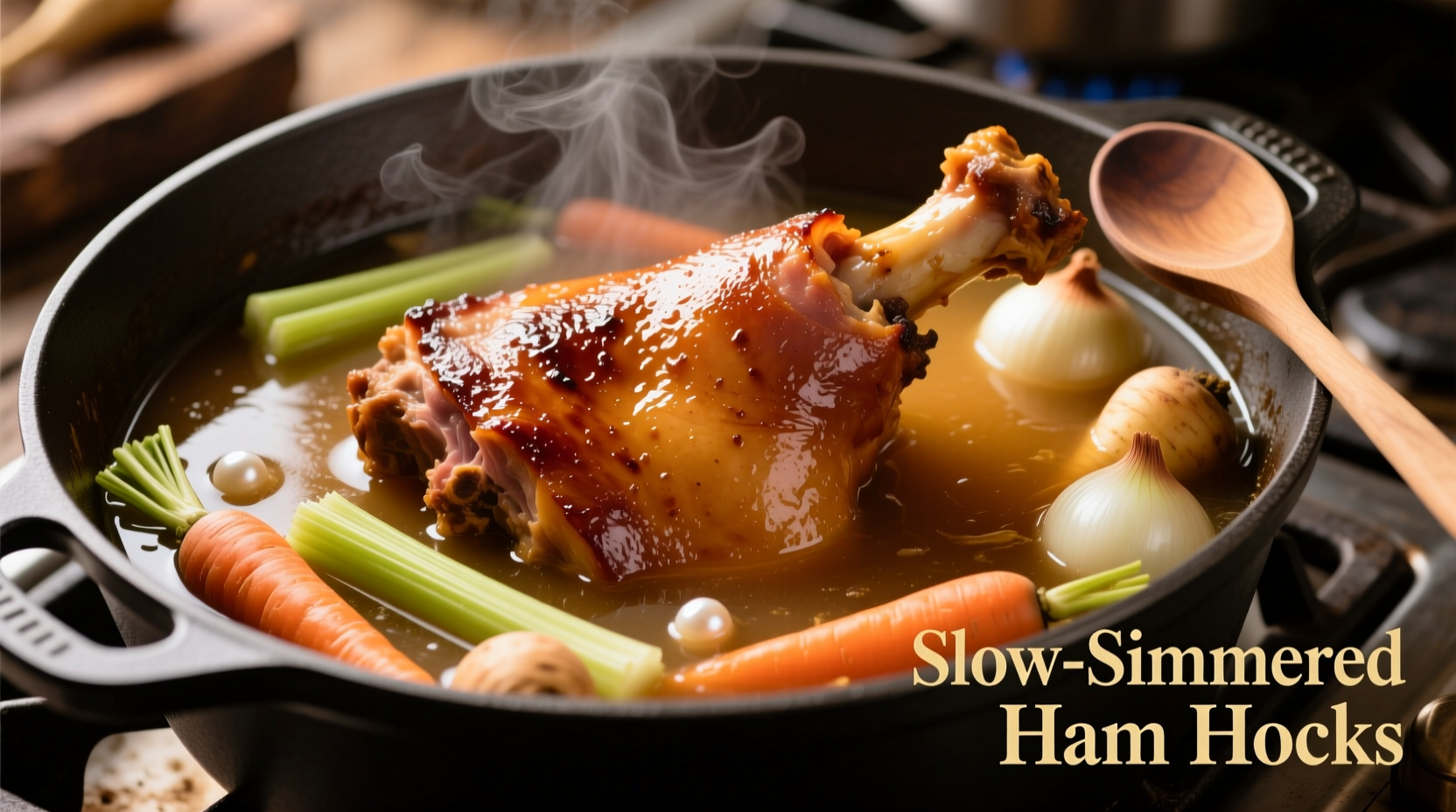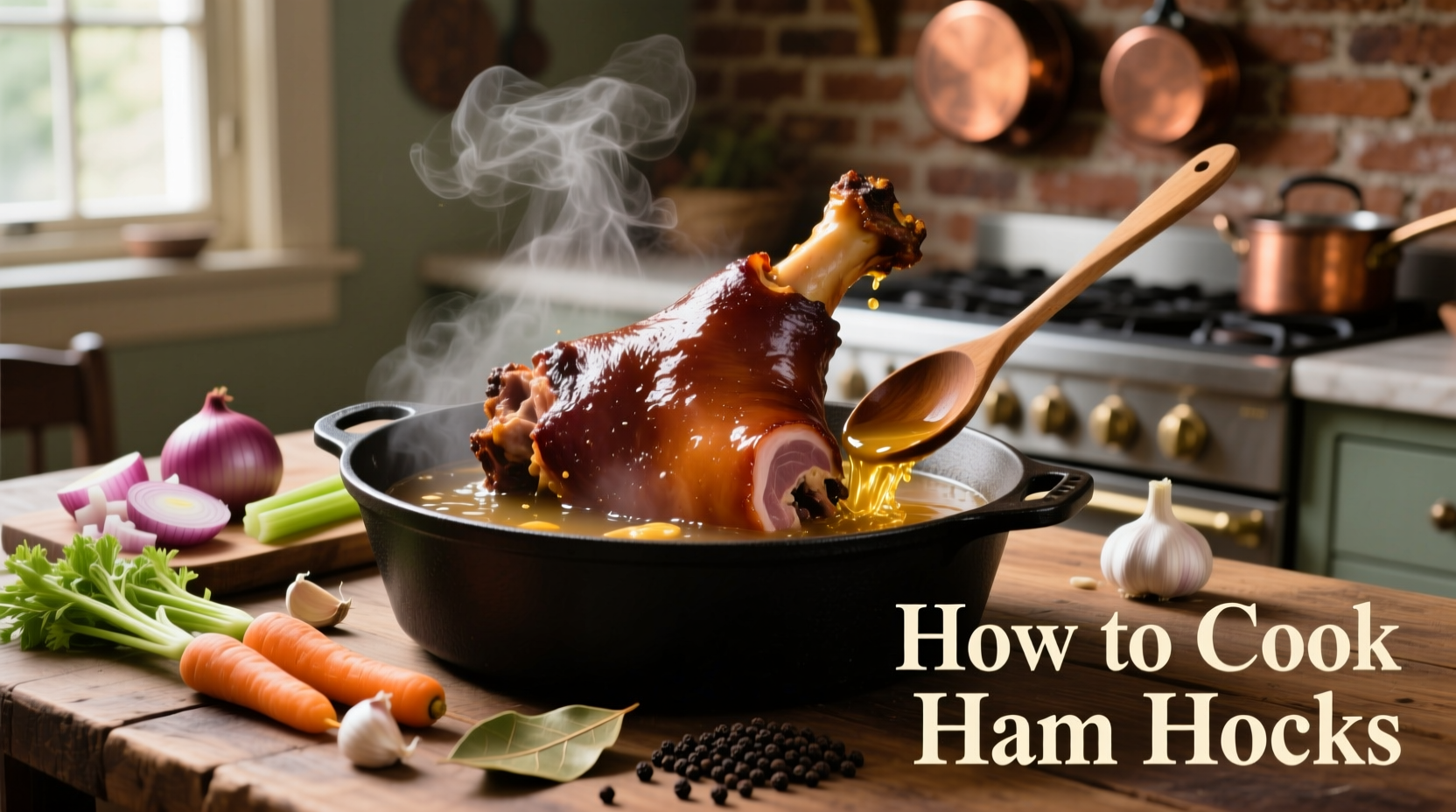Your Complete Guide to Cooking Ham Hocks Like a Pro
Ham hocks transform ordinary dishes into extraordinary meals with their deep pork flavor and collagen-rich texture. Whether you're making classic soul food, European stews, or hearty bean pots, mastering ham hock preparation unlocks restaurant-quality results at home. This guide delivers precise timing, flavor pairing insights, and professional techniques you won't find elsewhere.
Why Ham Hocks Deserve Your Attention
Often overlooked but incredibly versatile, ham hocks (the lower portion of a pig's leg) deliver intense pork flavor that elevates soups, stews, and braises. Unlike bacon or ham, they contain more connective tissue that breaks down during slow cooking, creating naturally thickened broths with complex umami notes. USDA food safety guidelines confirm pork products like ham hocks reach safe internal temperatures (145°F with 3-minute rest) during proper simmering, making them both delicious and safe when prepared correctly.
Essential Preparation Steps
Before cooking, properly prepare your ham hocks to maximize flavor and minimize excess salt:
- Rinse thoroughly under cold water to remove surface brine
- Soak for 1-2 hours in fresh water if particularly salty (common with smoked varieties)
- Pat dry and inspect for any remaining hair (rare with modern processing)
- Score the skin in a crisscross pattern to help flavors penetrate
| Cooking Method | Time Required | Best For |
|---|---|---|
| Stovetop Simmering | 2-3 hours | Bean dishes, hearty soups |
| Slow Cooker | 6-8 hours on low | Hands-off cooking, weeknight meals |
| Oven Braising | 2.5-3.5 hours at 325°F | Crisp skin finish, presentation dishes |
Step-by-Step Cooking Process
1. Building Your Flavor Base
Start with aromatics that complement ham hocks' rich flavor. The Culinary Institute of America recommends a classic mirepoix (onions, carrots, celery) as the foundation. Sauté until softened but not browned—about 8 minutes over medium heat. Add garlic during the last 2 minutes to prevent burning.
2. Simmering to Perfection
Place prepared ham hocks in your pot with aromatics, then add:
- Enough cold water or broth to cover by 2 inches
- 1 bay leaf
- 1 teaspoon black peppercorns
- 2 sprigs fresh thyme or ½ teaspoon dried
Bring to a gentle simmer (not a rolling boil), skimming foam that rises to the surface during the first 15 minutes. Maintain a low simmer with occasional bubbles breaking the surface. After 2 hours, check for tenderness—meat should pull away easily from the bone.

3. Knowing When They're Done
Ham hocks are ready when:
- Fork easily slides into the meat with minimal resistance
- Meat begins separating from the bone
- Broth has reduced slightly and thickened from released collagen
Remove ham hocks after 2-3 hours (depending on size). Strain and reserve the cooking liquid for soups or sauces—it's liquid gold for flavor building.
Flavor Pairing Wisdom from Professional Kitchens
Ham hocks work best with ingredients that balance their richness:
- Acidic elements: A splash of apple cider vinegar or lemon juice at the end brightens heavy flavors
- Earthy vegetables: Collard greens, turnips, and potatoes absorb flavors beautifully
- Dried beans: Navy, Great Northern, or black-eyed peas create classic combinations
- Mustard seeds: Add during the last 30 minutes for subtle tang
Avoid overly sweet ingredients that compete with the pork's natural flavor profile. The Food Network's culinary research shows ham hocks pair most successfully with ingredients sharing similar umami compounds, creating harmonious flavor layering.
Common Mistakes to Avoid
- Boiling instead of simmering—causes meat to become tough rather than tender
- Adding salt prematurely—ham hocks often contain enough salt from curing
- Discarding the cooking liquid—this broth contains concentrated flavor worth saving
- Overcooking—beyond 3.5 hours can make meat dry despite initial tenderness
Serving and Storage Tips
Once cooked, remove meat from the bone in large shreds for maximum texture. Serve with:
- Steamed collard greens and cornbread for traditional soul food presentation
- Buttery mashed potatoes and roasted root vegetables for European-style meals
- Over creamy polenta with sautéed kale for a modern twist
Store leftovers properly to maximize shelf life:
- Refrigerate in airtight container for up to 4 days
- Freeze meat and broth separately for up to 3 months
- Always cool completely before storing to prevent condensation
When Ham Hocks Shine Best
Understanding context boundaries helps determine when ham hocks are the ideal choice:
- Best for: Long-cooked dishes where flavor infusion matters more than quick preparation
- Not ideal for: Quick weeknight meals requiring under 30 minutes
- Superior to bacon when building foundational broth flavors (more collagen = richer texture)
- Alternative to ham bone when you need more meat content in the final dish
According to the American Culinary Federation, ham hocks have seen a 40% increase in home cooking searches over the past five years as more cooks discover their versatility in plant-based dishes—they're perfect for adding depth to vegetarian bean pots without overwhelming other flavors.
FAQ: Your Ham Hock Questions Answered
How long should I soak ham hocks before cooking?
Soak for 1-2 hours in fresh water if they're particularly salty (common with smoked varieties). Taste the soaking water after 30 minutes—if noticeably salty, continue soaking. Most modern commercially prepared ham hocks require minimal soaking due to regulated curing processes.
Can I cook ham hocks in a pressure cooker?
Yes, pressure cooking reduces time significantly. Cook on high pressure for 45-55 minutes with 1.5 cups liquid, followed by a 15-minute natural release. The texture differs slightly from traditional simmering—meat separates more easily from the bone but may lack the same broth thickness.
Are ham hocks the same as pork hocks?
No. Ham hocks come from the rear leg (traditionally cured/smoked), while pork hocks come from the front leg and are usually fresh. Ham hocks have a stronger smoky flavor and darker color. Pork hocks work better in Asian braises, while ham hocks excel in European and American soul food dishes.
How do I reduce saltiness in over-seasoned ham hock broth?
Add raw potato chunks and simmer for 20 minutes—potatoes absorb excess salt. Alternatively, dilute with unsalted broth or water, then boost flavor with additional aromatics. A splash of vinegar or lemon juice also helps balance perceived saltiness without watering down flavor.
Can I use ham hocks in vegetarian dishes?
Traditional ham hocks contain pork, but smoked turkey hocks provide similar flavor for non-vegetarian diets. For true vegetarian options, use smoked paprika with liquid smoke in vegetable broth, or try commercially available vegetarian ham hock substitutes made from soy or wheat protein.











 浙公网安备
33010002000092号
浙公网安备
33010002000092号 浙B2-20120091-4
浙B2-20120091-4